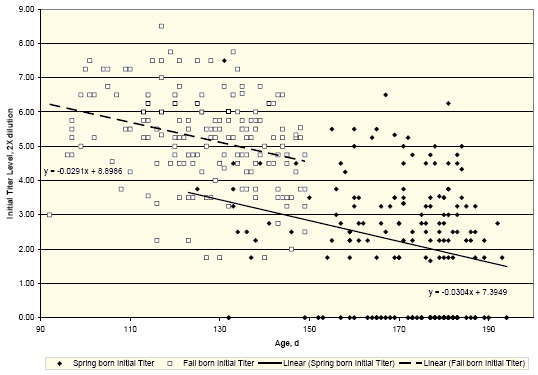



Environmental Factors Impacting BVD Vaccines in Angus Calves
This study evaluates the impact of environmental factors on the serological response to commercial bovine viral diarrhea type vaccinations in Angus cattle for inclusion as fixed effects into subsequent genetic evaluations for response to vaccination. This article, prepared by Matt Schneider, J R Tait, Julia Ridpath, and Jim Reecy, was published in the Iowa State University Animal IndustryReport 2009 Summary and Implications
The age of the calf was found to have a significant effect on the serum titer level at the time of initial vaccination, with older calves halving a lower titer level. Furthermore, it was observed that animals with a higher serum titer level at the time of vaccination had a reduced increase in titer as a result of a vaccination. We also observed smaller response to vaccination in calves which experienced the stress of weaning at the same time as their initial vaccinations.
Based on this initial study, we have adjusted experimental protocols for subsequent work to collect samples to evaluate individual animal rate of maternal antibody decline and to remove confounding of stress of weaning with calving season effects.
Introduction
Bovine respiratory disease is a very significant disease effecting feedlot cattle across the US. Many preconditioning programs include vaccinations for (BVDV2) in their protocols to help reduce the incidence of bovine respiratory disease in the feedlot. We are interested in evaluating the genetic control of response to respiratory disease vaccines as a potential new economically relevant trait for beef cattle selection in the future.
When beginning to investigate genetic control of a new trait, it is also important to characterize non-genetic effects on that trait. An example of this concept can be adapted from weaning weight EPD calculations. Weaning records are typically adjusted to a constant age before calculation of EPDs for weaning weight because it is well documented that cattle get heavier as they get older. Therefore, the objective of this study was to evaluate the impact of environmental factors on the serological response to vaccination for a commercial BVDV2 vaccine.
Materials and Methods
This study utilized 353 Angus calves born in spring (n = 176) and fall (n = 177) calving seasons of 2006 in the Iowa State University Angus Breeding Project. Two vaccinations, initial and booster, were administered approx. 3 weeks apart. Blood serum samples were collected at time of initial vaccination, booster vaccination, and approx. 2 weeks after booster vaccination for response to booster. Spring calves were weaned and given initial vaccination at the same time, while fall calves were weaned at the time of booster vaccination administration (Figure 1).
Figure 1. Design layout with distribution of ages of
2006 spring or fall born calf management groups and
timing of weaning during response to BVDV2 vaccination study.

The level of neutralizing antibodies present in sera was titered via serum neutralization tests using cytopathic BVDV2. Briefly, each serum was serially diluted 1:2 and the highest dilution of serum which was still capable of neutralizing virus was determined. All tests were run in triplicate. The reciprocal of the average of the highest dilution, which had virus neutralizing activity, was recorded as the serum titer.
Response to initial vaccination was calculated as serum titer at time of booster vaccination minus serum titer at time of initial vaccination. Response to booster vaccination was calculated as serum titer at time of booster response serum draw minus serum titer at time of booster vaccination. Overall response to initial and booster vaccination was calculated as serum titer level at time of booster response serum draw minus serum titer level at time of initial vaccination.
Results and Discussion
Means, standard deviations, and ranges for ages and titer levels at initial vaccination, booster vaccination, and response to booster vaccination serum draw are presented in Table 1 by calving group.
Titer levels at the time of first vaccination were not influenced by gender (P = 0.13) but were influenced by calving group (spring or fall) (P < 0.001) and calf age (P < 0.001) (Figure 2). This observation may result from a higher level of maternal antibodies in younger calves. There was no interaction between group and age of calf covariate (P = 0.89) for titer level at the time of first vaccination, indicating maternal antibodies have a similar half-life in both calving groups.
Figure 2. Relationship between age of calf and initial
titer level before exposure to BVDV2 vaccine.

When evaluating the response to the different vaccinations (initial, booster, and overall initial and booster) we evaluated the significance of class effects of calving season and gender of calf as well as covariates for serum titer level at the time of vaccination, age at the time of vaccination, and weight at the time of vaccination. Significance level for these effects and estimates of the covariate effects are presented in Table 2.
Titer level at the time vaccination was consistently the most significant effect (P < 0.001 for all three response variables) for predicting response to vaccination strategy, with animals having a higher initial titer level experiencing a smaller increase in titer as a result of a vaccination strategy. Other effects tested for significance for prediction of response to vaccination included calving group, gender, age at vaccination, and weight at vaccination. Calving group was the next most significant effect for predicting response to initial vaccination and overall vaccination (P < 0.001 and P < 0.05, respectively). LSMeans estimates for the response to initial vaccination were -1.49 and 0.31 for the spring calving and fall calving groups respectively. Furthermore, LSMeans estimates for the response to overall vaccination program were 1.52 and 2.21 for spring calving and fall calving groups respectively. Therefore, it appears that stress of weaning at the same time as initial vaccination may limit the ability of animals to respond to a vaccine.
Unfortunately, the design of this study had confounding of some important effects. The first effect confounded between calving groups was the weaning strategy, with spring born calves all experiencing the stress of weaning at the time of initial vaccination and the fall born calves all experiencing the stress of weaning at the time of booster vaccination. Also, there was a general confounding of age of calf with these two calving groups. Generally, the spring calving group was older at the time of initial vaccination and was also generally older at the time of weaning. This lead to a number of animals in the spring calving group being old enough to have 0.00 serum titer level at the time of initial vaccination, whereas, the fall calving group did not have any animals with 0.00 serum titer level at the time of initial vaccination, thus potentially limiting the response to the initial vaccination in the fall born group.


